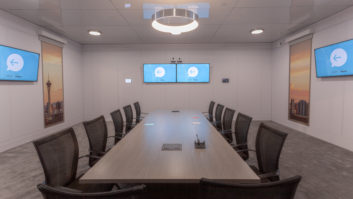It has been widely observed that the events of the last 18 months have served to accelerate a number of technology trends that were already tangible before the pandemic. That can certainly be said of unified communications (UC), where the need to accommodate more flexible collaboration and support the growing tendency towards remote working had been exerting an influence on system design and delivery for some time.
Now as we begin to contemplate post-pandemic working life, it is becoming apparent quite how different our UC requirements might become. With few companies set to be untouched by hybrid working and most team meetings likely to involve at least one remote participant, systems will need to have flexibility and scalability at their core. They will also have to deliver the best possible experience to all participants – their domestic bandwidth situation notwithstanding. Moreover, with many more people likely to be joining sessions separately at home or on the move, maintaining security is certain to be a high priority.
BUSINESS FUTURES
In this context it’s no surprise that there is much talk of Unified Communications as a Service (UCaaS) representing the future for many larger businesses. The forecasts certainly seem to bear this out, with Fortune Business Insights predicting in October 2021 that the global UCaaS market will register a compound annual growth rate of 13.4% by 2028, bringing its total value to US$69.93bn. But even among those organisations who don’t adopt this route, their expectations of UC systems will be such that vendors and integrators will have to be more proactive than ever.
There is a general consensus that the headline news about UC coming out of the pandemic is that – thanks to Zoom, Microsoft Teams and other high-profile platforms – awareness of UC is at an all-time high. Moreover, the usability and personalisation capacity experienced with these platforms will continue to be expected by employees whether they are joining a call from the office or at home.
Rob Smith, senior director integrated systems sales at Shure, observes: “The ease of use that people have experienced with Zoom, MS Teams and other desktop platforms will have set their expectations that room systems be as simple to use in the future, and that the system they have been using from home during the pandemic will be available in the meeting room when they return to the office. Coupling that with an increased interest in hybrid working, and the resultant need to cater for room-to-room and room-to-home calls, and I believe both the user expectations and the use case will have changed for many companies.”
Gavin Sear, EMEA product marketing lead at Poly, agrees that a lot of the UC focus as more people return to the office will be on replicating the communications experience with which they have become comfortable. For example, “if it is Teams they are using they will want the interface [in the room] to feel the same. […] From a hardware perspective, if people want to go down the BYOD route, then there is a need to keep the whole experience as consistent as possible – from the home office back to the meeting room.”
DECISION MAKING
Beyond the baseline interaction with UC, the last 18 months have also turned the spotlight on collaboration and decision-making. Hence it’s likely that we’ll see more steps taken to boost in-meeting collaboration and remove any remaining barriers that might prevent people from feeling excluded from the conversation.
Lorrissa Horton, vice-president and general manager of Webex Calling and Online at Cisco, confirms that there is “a lot of interest” around the user experience and the need to have a “democratised, equal experience for all.” Hence, as well as a continued focus on providing a consistent participation across hardware, software and user device, there has also been an emphasis on features such as whiteboards within WebEx that allow anyone in the meeting to contribute or participate on an equal basis. Capabilities like this, adds Horton, are “becoming more and more critical as we go into hybrid working”.
Meanwhile, as meetings become more diverse and internationalised, demand for real-time translation is likely to increase. For Cisco, Horton points to the ability of Webex to translate the meeting conversation in real-time from English to one of over 100 different languages.
Stijn Ooms, director product strategy AV and digital workplace at Crestron, also highlights the need for engagement of all participants, including through the use of intelligent video. “Ineffective video collaboration can drive the disconnect if all participants do not have an equal seat in meetings,” he says. “By implementing intelligent video, both in-person and remote participants can more effectively engage in the meeting, spurring more effective brainstorming and collaboration, resulting in better meetings and more engagement amongst employees. Intelligent video promotes an experience where every person, in the room or remotely, is represented equally by framing everyone separately, no matter the location.”
It’s an objective that requires attention to both software and hardware, says Ooms: “Software alone won’t solve this challenge. Room systems with intelligent audio and video features, paired with the software innovations from meeting service providers, ensure all meeting participants can easily contribute and productively collaborate.”
ENHANCED AWARENESS
Whilst HD and, in some cases 4K, video is now expected as standard, there are also signs of a comparable increase in audio requirements – sharpened, no doubt, by the somewhat variable
sound quality many of us will have experienced at one time or another during the pandemic.
Shure’s Smith observes: “Over the last year many people will have experienced the fatigue and irritation caused by poor quality audio in meetings. With the increased interest in hybrid working companies will need to be sure that the user experience is excellent wherever a person is joining a meeting from. One of the biggest challenges to making a meeting work when some of the participants are working from home is the audio quality at both ends.”
Taking steps to ensure that everyone – whether joining on-site or remotely – can experience consistently good audio will be critical. For example, the use of noise removal technology is bound to become more habitual. “Background noise, such as typing, needs to be eliminated using technologies such as Shure’s recently introduced De-Noiser upgrade (available free for most of our Microflex Ecosystem products) to make the meeting a smooth and productive experience for all participants,” says Smith, who also points to Shure’s 2020 acquisition of the collaboration space audio-optimising Stem Ecosystem as a significant move [see page 12 for more on Stem].
SIZE AND SECURITY
Other changes we are likely to see – at least in the short-to-medium term – are a greater variety of meeting spaces. “There had been a move towards huddle rooms, but that’s not what so many people are wanting now; instead, they want spaces that are more airy and have greater space,” says Poly product and solutions marketing manager EMEA Jonathan Clark, although he agrees that there will continue to be a demand for “flexibility and getting the right balance between simplicity of [UC ] design and user [requirements]”.
Meanwhile, security is also bound to be at the top of the priority list, not least because of the recent surge in cyberattacks. A recent report by Check Point Research makes for especially troubling reading, pointing to a 29% global rise in cyberattacks in the first six months of 2021, and in the case of ransomware, a 93% increase (https://pages.checkpoint.com/cyber-attack-2021-trends.html). All companies must take heed, although it will be especially vital in sectors such as financial services, where there are strict compliance rules.
Ooms offers a few tips: “People who are working from home should always be reminded that they are not on the corporate network. Home network security often doesn’t meet the more stringent policies of companies, [and] there will be other non-corporate devices on the network. Home workers should make sure that their home router is up to date and their network connection is properly secured. Simultaneously, we educate our installers via training, both live and webinars, about security considerations, including the importance of firmware updates.”
Whatever UC platform companies decide to standardise on, the onus will be on providers to “do continual updates to firmware and hardware, and provide patches as and when required,” says Sear. “For instance, we can provide firmware updates over our Poly Lens [device management software] and IT can push those out to all remote users.”
Samuel Tourbot, head of cloud sales at Alcatel-Lucent Enterprise, points to the need for US-based companies to comply with the Patriot Act and how an extension of it, called the CLOUD Act, makes sure they comply outside the US as well. “This regulation puts any data stored with the provider at risk of being shared with third parties,” he says. “A lot of countries are also defining regulations to encompass a certain level of data integrity. It is important that vendors invest in these areas to comply with rules and reinforce their commitment to protecting customer data.”
MARKET MOMENTUM
Meanwhile, it seems likely that we will also see more adoption of SASE (secure access service edge) services as hybrid working takes hold. Originally coined by Gartner analysts Neil McDonald and Joe Skorupa in 2019, the term acknowledges the move towards mobile, edge and cloud computing. As a result, advocates claim, it is possible to minimise latency and performance issues by transferring more security and wide area networking activities to the edge. And although it’s still early days for SASE adoption, it’s possible to see it being melded with Network as a Service (NaaS) and/or UCaaS offers to deliver combined cloud subscription model-based services.
In this and other ways, accelerated innovation will continue to underpin UC’s development. For Alcatel-Lucent – whose presence in the market includes the Rainbow business communication solutions – Tourbot notes that innovation is “expected on an almost daily basis to anticipate future user, or company, needs as well as potential disasters and crises.” Nonetheless, he predicts “stable growth” for the UC market and continued expansion to other sectors and industries, “especially when the benefit of real-time communication and collaboration is so clear”.
Tourbot also points to the likelihood of more data-sharing between organisations and the replication of communication streams using AI and IoT integration to alleviate employee workload. But whatever changes may come, he adds, “it is clear they will revolve around making our lives easier – through automating business processes, lightening the workload, raising resolution rates, or improving the overall quality of life. The best years of unified communications are yet to come, and we are proud to be at the centre of it






